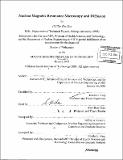Nuclear magnetic resonance microscopy and diffusion
Author(s)
Sun, Phillip Zhe
DownloadFull printable version (5.458Mb)
Alternative title
NMR microscopy and diffusion
Other Contributors
Massachusetts Institute of Technology. Dept. of Nuclear Engineering.
Advisor
David G. Corey.
Terms of use
Metadata
Show full item recordAbstract
The goal of the work described in this thesis is to develop the methodology and instrumentation for studying neuron physiology and activation in vivo at near cellular resolution. Using biocompatible crosslinked Hemoglobin (xHb) as a contrast agent, we demonstrated partial local oxygen pressure (pO₂) monitoring in vivo with a home-built high resolution microscopy imaging probe. It is one of the most stable microimaging system designed and fully equipped for microscopic fMRI study. This work is an advancement of using MRI to study fundamental neuron science and cell signal pathways in vivo. NMR Microscopy of pancreatic islet of NOD-SCID mice in vitro has shown the feasibility of tracking T-lymphocytes infiltration into islets before the onset of any diabetes symptoms using contrast agents CLIO-Tat. Application of this to in vivo study will not only advance our understanding of the progression IDDM but also help monitor the treatment and prognosis of IDDM patients. Throughout the high resolution imaging studies at high field (14.1 T), a new gradient sequence was developed to suppress the distortion due to the internal fields. This sequence can faithfully measure the displacement propagator in q-space imaging, and provide the proper displacement contrast in k-space imaging. The constant time imaging technique has been used to image a phantom model of a vascular system. It is made up of two glass tubes, filled with solutions of D[sub]y - DTPA and C[sub]uSO₄ respectively and the field mapping showed significant internal field introduced by their susceptibility difference. The new sequence may find applications in clinical Diffusion Tensor Imaging (DTI) and Diffusion Weighted Imaging (DWI).
Description
Thesis (Ph. D.)--Massachusetts Institute of Technology, Dept. of Nuclear Engineering, 2003. Includes bibliographical references.
Date issued
2003Department
Massachusetts Institute of Technology. Department of Nuclear Engineering; Massachusetts Institute of Technology. Department of Nuclear Science and EngineeringPublisher
Massachusetts Institute of Technology
Keywords
Nuclear Engineering.